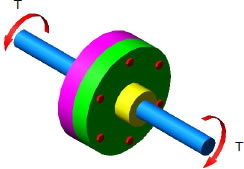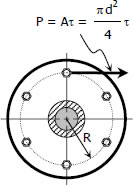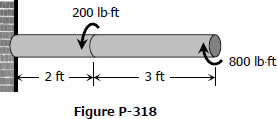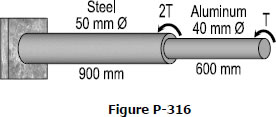Solution to Problem 327 | Flanged bolt couplings
Problem 327
A flanged bolt coupling consists of ten steel ½-in.-diameter bolts spaced evenly around a bolt circle 14 in. in diameter. Determine the torque capacity of the coupling if the allowable shearing stress in the bolts is 6000 psi.
Solution to Problem 326 | Flanged bolt couplings
Problem 326
A flanged bolt coupling consists of ten 20-mm-diameter bolts spaced evenly around a bolt circle 400 mm in diameter. Determine the torque capacity of the coupling if the allowable shearing stress in the bolts is 40 MPa.
Flanged bolt couplings
In shaft connection called flanged bolt couplings (see figure), the torque is transmitted by the shearing force P created in he bolts that is assumed to be uniformly distributed. For any number of bolts n, the torque capacity of the coupling is


- Read more about Flanged bolt couplings
- Log in to post comments
Solution to Problem 324 Torsion
Problem 324
The compound shaft shown in Fig. P-324 is attached to rigid supports. For the bronze segment AB, the maximum shearing stress is limited to 8000 psi and for the steel segment BC, it is limited to 12 ksi. Determine the diameters of each segment so that each material will be simultaneously stressed to its permissible limit when a torque T = 12 kip·ft is applied. For bronze, G = 6 × 106 psi and for steel, G = 12 × 106 psi.
- Read more about Solution to Problem 324 Torsion
- Log in to post comments
Solution to Problem 320 Torsion
Problem 320
In Prob. 319, determine the ratio of lengths b/a so that each material will be stressed to its permissible limit. What torque T is required?
- Read more about Solution to Problem 320 Torsion
- 2 comments
- Log in to post comments
Solution to Problem 319 Torsion
Problem 319
The compound shaft shown in Fig. P-319 is attached to rigid supports. For the bronze segment AB, the diameter is 75 mm, τ ≤ 60 MPa, and G = 35 GPa. For the steel segment BC, the diameter is 50 mm, τ ≤ 80 MPa, and G = 83 GPa. If a = 2 m and b = 1.5 m, compute the maximum torque T that can be applied.
- Read more about Solution to Problem 319 Torsion
- Log in to post comments
Solution to Problem 318 Torsion
Problem 318
A solid aluminum shaft 2 in. in diameter is subjected to two torques as shown in Fig. P-318. Determine the maximum shearing stress in each segment and the angle of rotation of the free end. Use G = 4 × 106 psi.

- Read more about Solution to Problem 318 Torsion
- 1 comment
- Log in to post comments
316 Permissible Torque That Can Be Applied to a Compound Shaft
Problem 316
A compound shaft consisting of a steel segment and an aluminum segment is acted upon by two torques as shown in Fig. P-316. Determine the maximum permissible value of T subject to the following conditions: τst ≤ 83 MPa, τal ≤ 55 MPa, and the angle of rotation of the free end is limited to 6°. For steel, G = 83 GPa and for aluminum, G = 28 GPa.
313 Maximum Torque That Can be Applied to a Hollow Steel Shaft
Problem 313
Determine the maximum torque that can be applied to a hollow circular steel shaft of 100-mm outside diameter and an 80-mm inside diameter without exceeding a shearing stress of 60 MPa or a twist of 0.5 deg/m. Use G = 83 GPa.


